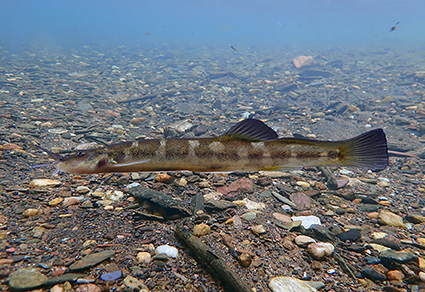Abstract
The mountain ranges of southeastern and southern Brazil are inhabited by a great diversity of catfishes of the genus Cambeva. The Cambeva variegata group, diagnosed by having a prominent skin crest similar to an adipose fin, an interrupted supraorbital laterosensory canal, with an additional supraorbital S4 pore, and a relatively small premaxilla with an accentuated constriction on its lateral portion, occurs in a broad area of south-eastern Brazil, mostly within the savannah-like Cerrado vegetation at the northern-most part of the genus distribution. The new species described here was collected in streams of the Rio das Velhas drainage, Rio São Francisco basin, draining the Serra do Espinhaço. The new species is diagnosed by having more interopercular odontodes and a combination of morphometric data, colour pattern, relative dorsal-fin origin and vertebra position, and-fin-ray morphology. Field studies indicate that the two localities where the new species occur are being dramatically affected by negative human impacts, putting it in severe risk of extinction.
References
- Azevedo-Santos, V.M., Arcifa, M.S., Brito, M.F., Agostinho, A.A., Hughes, R.M., Vitule, J.R.S., Simberloff, D., Olden, J.D. & Pelicice, F.M. (2021) Negative impacts of mining on Neotropical freshwater fishes. Neotropical Ichthyology, 19, e210001. https://doi.org/10.1590/1982-0224-2021-0001
- Azevedo-Santos, V.M., Daga, V.S., Tonella, L.H., Ruaro, R., Arcifa, M.S., Fearnside, P.M. & Giarrizzo, T. (2023) Brazil’s urban ecosystems threatened by law. Land Use Policy, 131, 106721. https://doi.org/10.1016/j.landusepol.2023.106721
- Arratia, G. & Huaquin, L. (1995) Morphology of the lateral line system and of the skin of diplomystid and certain primitive loricarioid catfishes and systematic and ecological considerations. Bonner Zoologische Monographien, 36, 1–110.
- Bockmann, F.A. & Sazima, I. (2004) Trichomycterus maracaya, a new catfish from the upper rio Paraná, southeastern Brazil (Siluriformes: Trichomycteridae), with notes on the T. brasiliensis species-complex. Neotropical Ichthyology, 2, 61–74. https://doi.org/10.1590/S1679-62252004000200003
- Costa, W.J.E.M. (1992) Description de huit nouvelles espèces du genre Trichomycterus (Siluriformes: Trichomycteridae), du Brésil oriental. Revue française d’Aquariologie et. Herpetologie, 18, 101–110.
- Costa, W.J.E.M. (2021) Comparative osteology, phylogeny and classification of the eastern South American catfish genus Trichomycterus (Siluriformes: Trichomycteridae). Taxonomy, 1, 160–191. https://doi.org/10.3390/taxonomy1020013
- Costa, W.J.E.M., Feltrin, C.R.M., Mattos, J.L.O., Dalcin, R.H., Abilhoa, V. & Katz, A.M. (2023a) Morpho-Molecular Discordance? Re-Approaching Systematics of Cambeva (Siluriformes: Trichomycteridae) from the Guaratuba-Babitonga-Itapocu Area, Southern Brazil. Fishes, 8 (63), 1–34. https://doi.org/10.3390/fishes8020063
- Costa, W.J.E.M. & Katz, A.M. (2021) Integrative taxonomy supports high species diversity of south-eastern Brazilian mountain catfishes of the T. reinhardti group (Siluriformes: Trichomycteridae). Systematics and Biodiversity, 19, 601–621. https://doi.org/10.1080/14772000.2021.1900947
- Costa, W.J.E.M., Katz, A.M., Mattos, J.L.O., Amorim, P.F., Mesquita, B.O., Vilardo, P.J. & Barbosa, M.A. (2020) Historical review and redescription of three poorly known species of the catfish genus Trichomycterus from south-eastern Brazil (Siluriformes: Trichomycteridae). Journal of Natural History, 53, 2905–2928. https://doi.org/10.1080/00222933.2020.1752406
- Costa,W.J.E.M., Mattos, J.L.O., Azevedo-Santos, V.M., Feltrin, C.R.M., Amorim, P.F., Ottoni, F.P., Vilardo, P.J. & Katz, A.M. (2024) A poorly known catfish clade in an endangered Neotropical biodiversity hotspot: relationships and distribution patterns of the Cambeva variegata group (Siluriformes: Trichomycteridae). Fishes, 9, 116. https://doi.org/10.3390/fishes9040116
- Costa, W.J.E.M., Mattos, J.L., Barbosa, M.A., Vilardo, P.J. & Katz, A.M. (2023b) High endemism in an endangered biodiversity hotspot: phylogeny, taxonomy and distribution patterns of catfishes of the Psammocambeva alpha-clade (Siluriformes: Trichomycteridae) from the Rio Doce basin, Brazil. Fishes, 8 (474), 1–32. https://doi.org/10.3390/fishes8100474
- Costa, W.J.E.M., Mattos, J.L.O., Sampaio, W.M.S., Giongo, P., Almeida, F.B. de & Katz, A.M. (2022b) Phylogenetic relationships of a new catfish of the genus Trichomycterus (Siluriformes, Trichomycteridae) from the Brazilian Cerrado, and the role of Cenozoic events in the diversification of mountain catfishes. Zoosystematics and Evolution, 98, 151–164. https://doi.org/10.3897/zse.98.83109
- Giulietti, A.M., Pirani, J.R. & Harley, R.M. (1997) Espinhaço Range region, eastern Brazil. In: Davis, S.D., Heywood, V.H., Herrera-Macbryde, O., Villa-Lobos, J. & Hamilton, A.C., (Eds.), Centres of plant diversity: a guide and strategy for their conservation. IUCN Publication Unit, Cambridge, pp. 397–404.
- Katz, A.M., Barbosa, M.A., Mattos, J.L.O. & Costa, W.J.E.M. (2018) Multigene analysis of the catfish genus Trichomycterus and description of a new South American trichomycterine genus (Siluriformes, Trichomycteridae). Zoosystematics and Evolution, 94, 557–566. https://doi.org/10.3897/zse.94.29872
- Kubicek, K.M. (2022) Developmental osteology of Ictalurus punctatus and Noturus gyrinus (Siluriformes: Ictaluridae) with a discussion of siluriform bone homologies. Vertebrate Zoology, 72, 661–727. https://doi.org/10.3897/vz.72.e85144
- Pougy, N., Verdi, M., Martins, E., Loyola, R. & Martinelli, G. (Eds.) (2015) Plano de Ação Nacional para a conservação da flora ameaçada de extinção da Serra do Espinhaço Meridional. Instituto de Pesquisas Jardim Botânico do Rio de Janeiro, Rio de Janeiro, 100 pp.
- Reis, V.J.C. & de Pinna, M.C.C. (2022) Diversity and systematics of Trichomycterus Valenciennes 1832 (Siluriformes: Trichomycteridae) in the Rio Doce Basin: iterating DNA, phylogeny and classical taxonomy. Zoological Journal of the Linnean Society, 197, 344–441. https://doi.org/10.1093/zoolinnean/zlac018
- Taylor, W.R. & Van Dyke, G.C. (1985) Revised procedures for staining and clearing small fishes and other vertebrates for bone and cartilage study. Cybium, 9, 107–119.
- Vilardo, P.J., Katz, A.M. & Costa, W.J.E.M. (2023) Phylogeny and historical biogeography of neotropical catfishes Trichomycterus (Siluriformes: Trichomycteridae) from eastern Brazil. Molecular Phylogenetics and Evolution, 186, 107836. https://doi.org/10.1016/j.ympev.2023.107836


